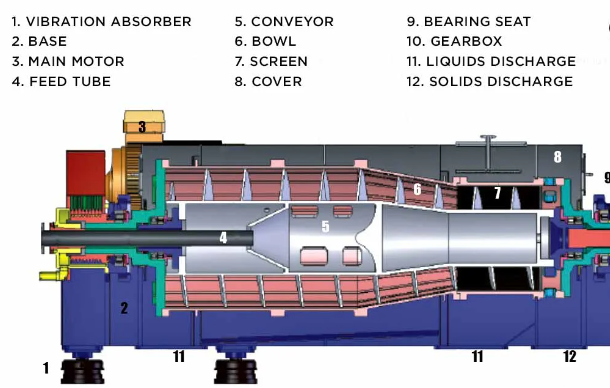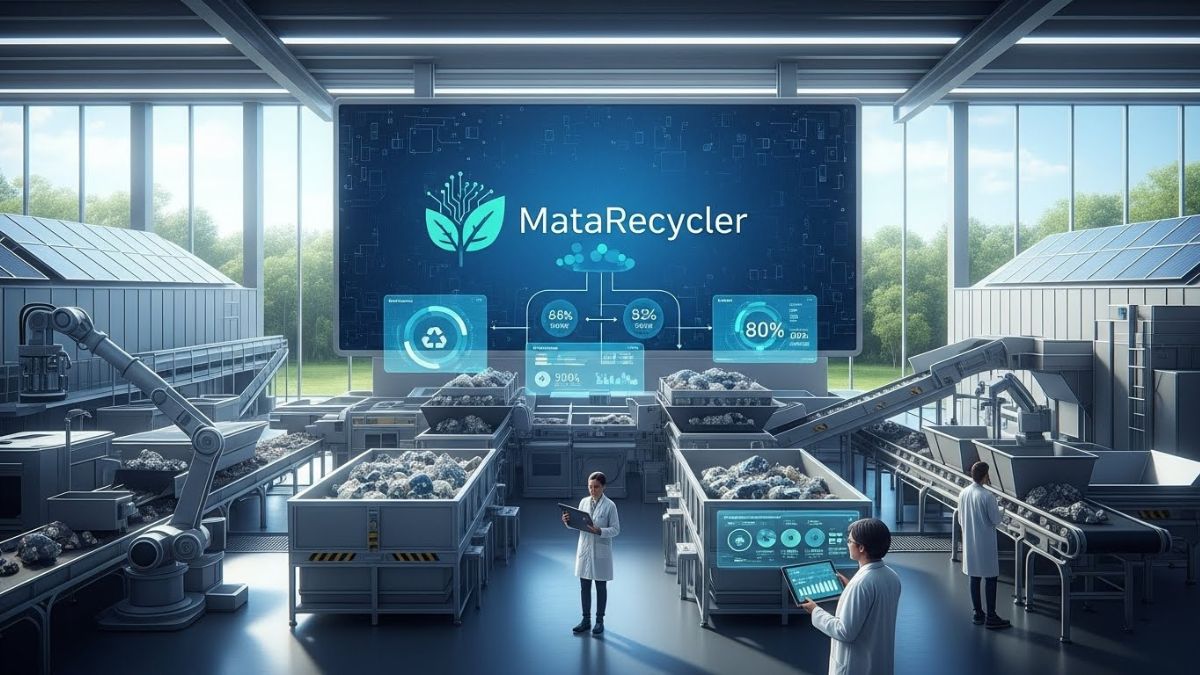TECHNOLOGY
The Science and Application of Decanter Centrifuges in Modern Industry

Introduction to Decanter Centrifuges
Decanter centrifuges have carved a niche in industrial separation processes, becoming an integral component in ensuring efficiency and effectiveness. These machines, designed to harness centrifugal force, efficiently separate solid particles from liquids, making them indispensable across numerous industries. Evolving from their simpler predecessors, decanter centrifuges today embody the marriage of time-tested mechanics and cutting-edge technology. They are essential in processes requiring precision and large-scale handling without sacrificing quality.
How Decanter Centrifuges Work
The underlying principle of decanter centrifuges is simple yet ingenious. These machines effectively exploit centrifugal force to segregate heterogeneous mixtures by rotating a cylindrical drum at high speeds. This process capitalizes on the difference in density between components; denser solid particles are flung outward against the drum, while lighter liquid fractions form an inner layer. To dive deeper into their applications, consider exploring this resource. The mechanism resembles natural sedimentation but at an accelerated pace and efficiency. Unlike other separation technologies, decanter centrifuges can process high volumes with minimal intervention, making them exceptionally suitable for continuous operation in demanding industrial environments.
Key Industries Benefiting from Decanter Centrifuges
The versatile nature of decanter centrifuges finds applications in diverse industries. In the oil and gas sector, they are critical in separating oil from drilling mud, contributing to the purification of resources and the environmental sustainability of operations. Wastewater treatment plants harness their power to efficiently process sludge, resulting in cleaner effluent discharge and reduced costs associated with waste management. The food industry also reaps benefits; for instance, decanter centrifuges clarify fruit juices and wines. Furthermore, the chemical industry relies on these machines to precisely separate components, ensuring the purity and integrity of chemical products.
Advantages of Using Decanter Centrifuges
Decanter centrifuges offer myriad advantages that make them highly desirable for industrial use. Their efficiency in handling high throughput and varied material types is unparalleled. This capability translates into reduced operational downtime and increased productivity. These machines are also designed to optimize energy consumption, lowering energy costs. They play a vital role in sustainable practices by minimizing waste production and aligning with the growing environmental concerns across industries. The ability of decanter centrifuges to operate continuously without frequent intervention further underscores their economic benefits, supporting industries in reducing labor costs without compromising efficiency.
Challenges and Considerations
Despite their advantages, the implementation of decanter centrifuges comes with its own set of challenges. A significant consideration is the need for skilled personnel to operate and maintain these complex machines effectively. Inadequate expertise can result in suboptimal performance or machine downtime, affecting productivity. Maintenance, although infrequent, can be expensive and time-consuming, necessitating a well-prepared plan. Furthermore, as industries strive to address environmental impacts, the disposal of solid byproducts remains a critical issue. Industries must ensure compliance with environmental regulations while finding innovative ways to manage the disposal of separated solids.
Future Trends in Centrifuge Technology
The future of decanter centrifuges is closely tied to technological advancements to enhance their efficiency and adaptability. With the integration of automation and AI, these machines are set to become even more precise and intuitive, reducing the likelihood of human error and improving operational efficiency. Such technologies facilitate real-time monitoring and analysis, allowing for more responsive and adaptive operation. As industries push towards sustainability, innovations will likely focus on energy-saving features and improved waste-handling capabilities. These trends underscore a future where decanter centrifuges will continue to lead in separation technology, supporting industries in meeting productivity and environmental goals.
Case Studies: Real-World Applications
Real-world applications of decanter centrifuges highlight their substantial contributions across industries. In the oil and gas sector, these machines have dramatically improved the efficiency of drilling operations by precisely separating oil from unwanted particulates, leading to enhanced resource recovery. Wastewater facilities utilizing decanter centrifuges report significant improvements in sludge management, resulting in cost savings and regulatory compliance. These facilities often document improved effluent quality and reduction in environmental footprint. Food and beverage industries also provide many successful applications, from wine clarification to olive oil extraction, where quality and yield have notably improved.
Conclusion: The Future of Industrial Separation Methods
The trajectory for industrial separation methods is promising, with decanter centrifuges at the forefront of this revolution. As industries adapt to ever-evolving demands, the flexibility and efficiency offered by these machines present unmatched advantages. Future developments will likely emphasize technological advancements, sustainability, and operational efficiency. Thus, decanter centrifuges will remain integral to industrial processes, driving progress and innovation while aligning with a sustainable future for global industrial practices.
TECHNOLOGY
The Ultimate Guide to Personalizing Your Space with wallapix

Your living space is a canvas, waiting for your unique touch. Enter wallapix, the innovative platform that transforms ordinary walls into extraordinary reflections of your personality. Imagine stepping into a room adorned with images capturing cherished memories, breathtaking landscapes, or vibrant artwork that speaks to you. With wallapix, personalizing your environment has never been easier or more enjoyable.
Whether you’re looking to create an inspiring home office, a cozy bedroom retreat, or an inviting living area full of warmth and character, wallapix offers versatile options tailored just for you. From customizable prints to various materials and formats, this tool empowers you to design spaces that truly resonate with who you are. Let’s explore how wallapix can help elevate your surroundings and make every corner feel uniquely yours!
Benefits of personalizing your space with wallapix
Personalizing your space with wallapix brings a fresh vibe to your home. It transforms blank walls into vibrant canvases that reflect your personality and style.
When you choose images that resonate with you, the environment becomes more inviting. A customized atmosphere fosters creativity and comfort, making it easier to unwind after a long day.
Additionally, personalized decor can spark conversations. Unique artwork or family photos often draw attention, allowing guests to connect over shared memories or stories behind the images.
Moreover, wallapix offers endless possibilities for customization. Whether it’s large-scale prints or smaller accents, the options allow for flexibility in design.
Creating a personalized look also boosts mental well-being. Surrounding yourself with cherished moments can evoke happiness and nostalgia every time you walk into the room.
How to use wallapix to create a unique and personalized look
Using wallapix is an exciting way to transform your space into something truly personal. Start by selecting images that resonate with you—whether they’re family photos, travel snapshots, or art pieces.
Once you’ve chosen your favorites, explore the various product options available on wallapix. You can create stunning canvas prints, custom posters, or even wallpaper featuring your unique designs.
The platform allows for easy customization of size and layout. Experiment with different arrangements until you find a configuration that feels just right for your room.
Don’t shy away from mixing styles and colors. A vibrant photo gallery can add depth to a neutral space while black-and-white images bring elegance wherever placed.
Consider incorporating text elements into your designs—a favorite quote or meaningful dates elevate the personalization factor further. Your walls will reflect who you are in no time!
Tips for choosing the right images for your space
Choosing the right images for your space can transform its atmosphere. Start by considering the room’s purpose. For a calming bedroom, opt for serene landscapes or soft abstract art.
Think about colors too. Select images that complement your existing decor and enhance the overall color scheme. Warm tones evoke coziness, while cool shades promote tranquility.
Don’t shy away from personal touches. Family photos or travel memories add character and warmth to any environment. These choices reflect who you are and make spaces feel inviting.
Size matters as well—large prints can serve as statement pieces, while smaller ones work best in clusters. Play with different arrangements before settling on a final layout to see what feels right in each area of your home.
Consider seasonal variations; swapping out images periodically keeps things fresh and exciting! Mixing styles also creates visual interest—just stay true to your unique taste throughout it all.
Creative ways to incorporate wallapix into different rooms
Transform your living room into a gallery with wallapix. Use large canvas prints to create a stunning focal point above the sofa. Choose family photos or breathtaking landscapes that resonate with your style.
In the bedroom, consider personalized photo collages on wall decals. They can surround your bed like an intimate storytelling piece, bringing warmth and personality to the space.
For home offices, custom motivational quotes paired with images of achievements can inspire productivity. Wallapix allows you to design these pieces uniquely suited to your aspirations.
Kitchens are perfect for fun and vibrant art pieces featuring food photography or culinary adventures. Brighten up the walls and make cooking feel even more enjoyable.
Bathrooms might seem tricky, but small framed prints or tiles showcasing serene nature scenes can add a spa-like atmosphere. Make every moment relaxing as you unwind in this personal oasis.
Testimonials from satisfied customers
Customers have shared their enthusiasm for wallapix, highlighting how it has transformed their living spaces. One user described the joy of seeing family memories come to life on their walls. The high-quality prints brought an emotional touch that was previously missing.
Another customer marveled at the ease of customization. They appreciated how simple it was to turn digital photos into stunning canvas art. This seamless process allowed them to express their creativity with minimal effort.
A third testimonial spoke about using wallapix in a home office. By personalizing the workspace with inspiring images, they found increased motivation and focus throughout the day.
These experiences underline how wallapix not only beautifies homes but also enhances everyday life through personalized touches that resonate deeply with individuals and families alike.
Conclusion
Personalizing your space can transform not only the look of your home but also how you feel within it. With wallapix, creating a unique atmosphere is both fun and easy. The platform offers an array of features that allow you to customize everything from prints to canvases.
As you explore ways to personalize your space with wallapix, remember that the right images are crucial in conveying your personality and style. Consider what resonates with you—whether it’s family photos, travel memories, or abstract art.
Integrating wallapix into various rooms opens up endless possibilities for creativity. Each room can tell its own story through carefully chosen designs and colors.
The experiences shared by satisfied customers show just how impactful wallapix can be in enhancing personal spaces. Their transformations serve as inspiration for anyone looking to make their living environments more inviting.
TECHNOLOGY
MataRecycler: Bridging Technology and Ecology in Waste Processing

Waste management is a pressing issue that affects communities worldwide. With millions of tons of waste generated daily, finding efficient and eco-friendly solutions has never been more critical. Traditional methods often fall short, leading to pollution and resource depletion. But what if there was a way to transform this challenge into an opportunity? Enter MataRecycler—a groundbreaking innovation at the intersection of technology and ecology designed to revolutionize how we think about waste processing. By harnessing advanced technologies, MataRecycler aims not only to streamline waste management but also to promote sustainability in our everyday lives. Let’s dive deeper into this transformative solution and explore how it’s reshaping the future of waste processing for good.
What is MataRecycler?
MataRecycler is an innovative platform designed to tackle the growing waste management crisis. It harnesses cutting-edge technology to create efficient solutions for processing various types of waste.
At its core, MataRecycler connects businesses and communities with advanced recycling facilities. This connection streamlines the collection and sorting of recyclable materials, reducing landfill contributions significantly.
The system employs smart algorithms that optimize routes for waste collection vehicles. By minimizing travel distances, it lowers carbon emissions while increasing efficiency in resource recovery.
Additionally, MataRecycler provides real-time data analytics to users. This transparency helps organizations track their waste output and make informed decisions about sustainability practices.
With a focus on eco-friendly operations, MataRecycler aims not just to recycle but also to educate on responsible consumption habits. The vision is clear: a cleaner planet through better waste management practices powered by technology.
The Role of Technology in Waste Processing
Technology plays a pivotal role in modern waste processing. It enables more efficient sorting, recycling, and disposal methods than ever before. With advancements in artificial intelligence and machine learning, facilities can now analyze waste streams with unprecedented accuracy.
Automated systems detect recyclables from general waste quickly. Robotics are increasingly employed to handle hazardous materials safely. This minimizes human exposure while maximizing recovery rates.
Data analytics also contribute significantly to optimizing operations. By analyzing patterns in waste generation, companies can implement better strategies for reduction and reuse.
Moreover, technology enhances public awareness about recycling practices through apps and online platforms. These tools inform users about local resources and encourage responsible consumption habits.
The integration of technology into the waste management sector not only improves efficiency but also fosters sustainability—a necessity for our planet’s future health.
How Does MataRecycler Work?
MataRecycler operates through an innovative blend of technology and sustainable practices. At its core, it utilizes advanced algorithms to identify and categorize waste materials efficiently.
Once the waste is collected, sensors scan for various types of recyclables. This ensures that everything from plastics to metals is sorted accurately. The data gathered helps optimize recycling processes in real-time.
Users can easily access the system via a user-friendly app. This interface provides insights into local waste management efforts and encourages community participation.
Moreover, MataRecycler promotes transparency by tracking where materials end up after processing. It not only reduces landfill contributions but also supports circular economy initiatives.
All these features work together seamlessly, making MataRecycler a pivotal tool in modern waste management strategies.
Benefits of Using MataRecycler
MataRecycler offers numerous benefits that make it an attractive solution for waste management. First, its advanced technology enhances efficiency in processing various types of waste. This means less time spent sorting and more materials recycled.
Another significant advantage is the ecological impact. By streamlining operations, MataRecycler reduces landfill contributions significantly. This promotes a cleaner environment and helps combat climate change.
Cost-effectiveness is another highlight of this system. Organizations using MataRecycler typically see reduced operational costs over time due to improved recycling rates and lower disposal fees.
Moreover, adaptability sets MataRecycler apart from conventional methods. It can be customized to fit different industries and waste streams, making it versatile for businesses large and small.
Community engagement grows with the use of MataRecycler. Educating users about sustainability fosters awareness and encourages responsible consumption habits throughout society.
Case Studies and Success Stories
MataRecycler has transformed waste management across various regions. A notable case is in a bustling urban area where traditional methods fell short. With MataRecycler’s technology, the local government increased waste diversion rates by 40%. This shift decreased landfill reliance and boosted recycling efforts.
In another instance, a manufacturing plant integrated MataRecycler’s solutions into its operations. They achieved a significant reduction in operational costs while improving their sustainability metrics. Employees reported greater engagement with eco-friendly practices.
Community involvement also flourished through educational programs supported by MataRecycler. Residents learned about proper recycling techniques and waste separation, leading to behavioral changes that benefited the environment.
These success stories illustrate how innovative approaches to waste processing can create measurable impacts in diverse settings. Each example highlights not just efficiency but also community empowerment and environmental stewardship at its core.
Future Plans and Expansion
MataRecycler is setting ambitious goals for the future. The team envisions an expansion that transcends geographical boundaries. New partnerships with municipalities and businesses around the globe are on the horizon.
Innovation remains a core focus. They plan to enhance their technology, making waste processing even more efficient. By integrating AI and machine learning, MataRecycler aims to optimize sorting processes.
Education and community involvement will also play crucial roles in their growth strategy. Workshops and training sessions are being developed to foster awareness about sustainable practices.
Additionally, exploring new markets presents exciting opportunities. Emerging economies can greatly benefit from MataRecycler’s solutions tailored to local needs.
Sustainability initiatives will expand beyond waste management into broader environmental projects as well. This holistic approach sets a clear vision for a greener planet through smarter resource management.
Conclusion:
The world faces a growing waste management crisis. As urbanization accelerates and consumption patterns shift, the amount of waste generated continues to climb. This issue not only harms the environment but also poses significant health risks to communities worldwide.
MataRecycler stands as a beacon of hope in this scenario. It is an innovative solution designed specifically for effective waste processing. By integrating advanced technology with eco-friendly practices, MataRecycler aims to streamline recycling efforts and reduce landfill dependency.
Technology plays an essential role in modernizing how we handle waste. With real-time data analytics and automated sorting systems, MataRecycler enhances efficiency while minimizing human error. These technological advancements are crucial for turning trash into reusable materials.
TECHNOLOGY
Unveiling dfcbktr: A Comprehensive Guide to Its Features and Benefits

Welcome to the world of dfcbktr, where innovation meets efficiency in ways you’ve never imagined. In today’s fast-paced digital landscape, businesses and individuals alike need a platform that stands out from the crowd. dfcbktr is designed not just to meet your needs but to elevate your operations, streamline processes, and unlock new opportunities.
Whether you’re an entrepreneur seeking growth or a professional looking for smarter solutions, dfcbktr has something valuable for you. This comprehensive guide will take you through its key features, unique advantages over competing platforms, and real-world success stories that showcase its transformative power. Get ready to explore how dfcbktr can change the way you work!
Key Features of dfcbktr
dfcbktr stands out with its user-friendly interface. Navigating through the platform is seamless, making it accessible for everyone.
One of its notable features is real-time analytics. Users can track performance metrics instantly, allowing for quick adjustments and informed decision-making.
Collaboration tools are also integrated within dfcbktr. Teams can communicate effectively, share insights, and work on projects together without any hassle.
The robust security measures ensure that data remains protected at all times. With encryption protocols in place, users can trust that their sensitive information is safe from unauthorized access.
Customization options further enhance user experience. Individuals and businesses can tailor settings to fit their specific needs, making the platform versatile across different industries.
Additionally, dfcbktr offers comprehensive support resources. From tutorials to customer service assistance, help is readily available whenever it’s needed.
How dfcbktr is Different from Other Platforms
dfcbktr sets itself apart by delivering a user-centric experience that prioritizes simplicity and efficiency. Unlike many platforms, it offers an intuitive interface designed for both beginners and seasoned users.
Customization is another hallmark of dfcbktr. Users can tailor their dashboards to fit individual needs, ensuring relevant information is always at hand. This adaptability fosters productivity in ways competitors often overlook.
Integration capabilities also shine here. dfcbktr seamlessly connects with various third-party applications, streamlining workflows without the hassle of switching between tools.
Moreover, customer support is more approachable compared to other platforms. The dedicated team behind dfcbktr ensures prompt assistance, helping users navigate challenges effortlessly.
Frequent updates keep the platform fresh and aligned with industry trends—something that not all rivals prioritize consistently. Each enhancement adds value for users looking for innovative solutions.
Benefits of Using dfcbktr for Businesses and Individuals
Businesses and individuals alike can harness the power of dfcbktr to streamline their operations. This platform offers a user-friendly interface that simplifies complex tasks, making it accessible for everyone.
One of the standout benefits is its scalability. Whether you’re a small startup or an established corporation, dfcbktr adapts to your needs effortlessly. You won’t feel overwhelmed as your business grows.
Collaboration tools within dfcbktr enhance teamwork. Real-time updates foster communication among team members, ensuring everyone stays aligned with goals and projects.
For individuals, dfcbktr provides opportunities for personal development through various resources and training modules. This empowers users to acquire new skills at their own pace.
Additionally, cost-efficiency plays a significant role in attracting users. The competitive pricing model ensures great value without compromising on quality or features—an essential factor for any budget-conscious organization or individual.user
Success Stories of Companies Using dfcbktr
Companies across various sectors have embraced dfcbktr with remarkable results. One notable success story comes from a mid-sized e-commerce retailer. By integrating dfcbktr into their operations, they streamlined inventory management and improved customer engagement. As a result, they saw a 30% increase in sales within just three months.
Another inspiring example is a tech startup that utilized dfcbktr for data analytics. This allowed them to harness insights that drove product innovation and marketing strategies. Their ability to pivot quickly led to securing vital partnerships and expanding their market reach significantly.
A local café chain also turned to dfcbktr for managing customer loyalty programs. The platform helped them personalize experiences based on individual preferences, boosting repeat visits by over 40%. Such diverse stories illustrate how dfcbktr can transform businesses by enhancing efficiency and fostering growth through tailored solutions.
How to Get Started with dfcbktr
Getting started with dfcbktr is a breeze. First, visit the official website and create an account. The sign-up process is straightforward and user-friendly.
Once you’re logged in, take a moment to explore the dashboard. Familiarize yourself with its layout and features. This will help you navigate seamlessly as you dive deeper into the platform.
Next, check out tutorials or demo content available on the site. These resources provide valuable insights into maximizing your experience with dfcbktr.
Don’t hesitate to connect with community forums or support channels if you have questions. Engaging with other users can enhance your understanding.
Begin experimenting! Start small by using basic functionalities before advancing to more complex features. Embrace this journey of discovery at your own pace while leveraging all that dfcbktr offers.
Conclusion:
The digital landscape is constantly evolving, and dfcbktr stands out as a powerful tool for both businesses and individuals. Its robust features cater to diverse needs, making it an attractive option in today’s competitive market.
By simplifying complex processes, dfcbktr ensures that users can focus on what truly matters. Whether you’re aiming to streamline operations or enhance customer engagement, this platform has demonstrated its effectiveness across various industries.
Success stories abound from organizations that have integrated dfcbktr into their workflows. These testimonials highlight the tangible benefits of leveraging such innovative technology. Companies report increased efficiency and improved outcomes after adopting this versatile platform.
-

 GENERAL2 years ago
GENERAL2 years agoDiscovering the Artistic Brilliance of Derpixon: A Deep Dive into their Animation and Illustration
-

 Posts2 years ago
Posts2 years agoSiegel, Cooper & Co.
-

 HEALTH2 years ago
HEALTH2 years agoTransformative Health Solutions: Unveiling the Breakthroughs of 10x Health
-

 Lifestyle2 years ago
Lifestyle2 years agoPurenudism.com: Unveiling the Beauty of Naturist Lifestyle
-

 FASHION2 years ago
FASHION2 years agoThe Many Faces of “λιβαισ”: A Comprehensive Guide to its Symbolism in Different Cultures
-

 Lifestyle2 years ago
Lifestyle2 years agoBaddieHub: Unleashing Confidence and Style in the Ultimate Gathering Spot for the Baddie Lifestyle
-

 Entertainment2 years ago
Entertainment2 years agoGeekzilla Podcast: Navigating the World of Pop Culture, Gaming, and Tech
-

 Lifestyle1 year ago
Lifestyle1 year agoSandra orlow: Unraveling the Story of an Iconic Figure
